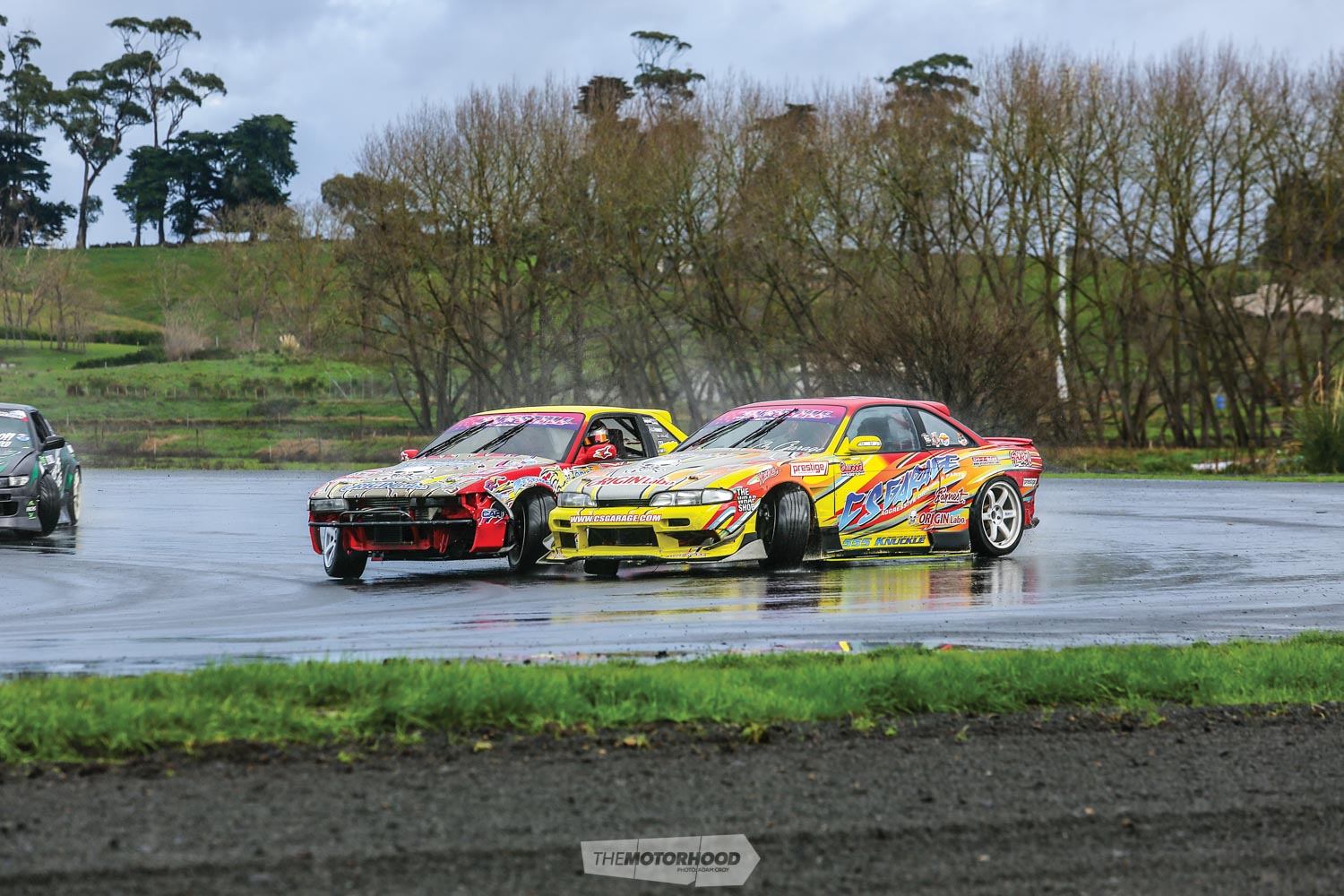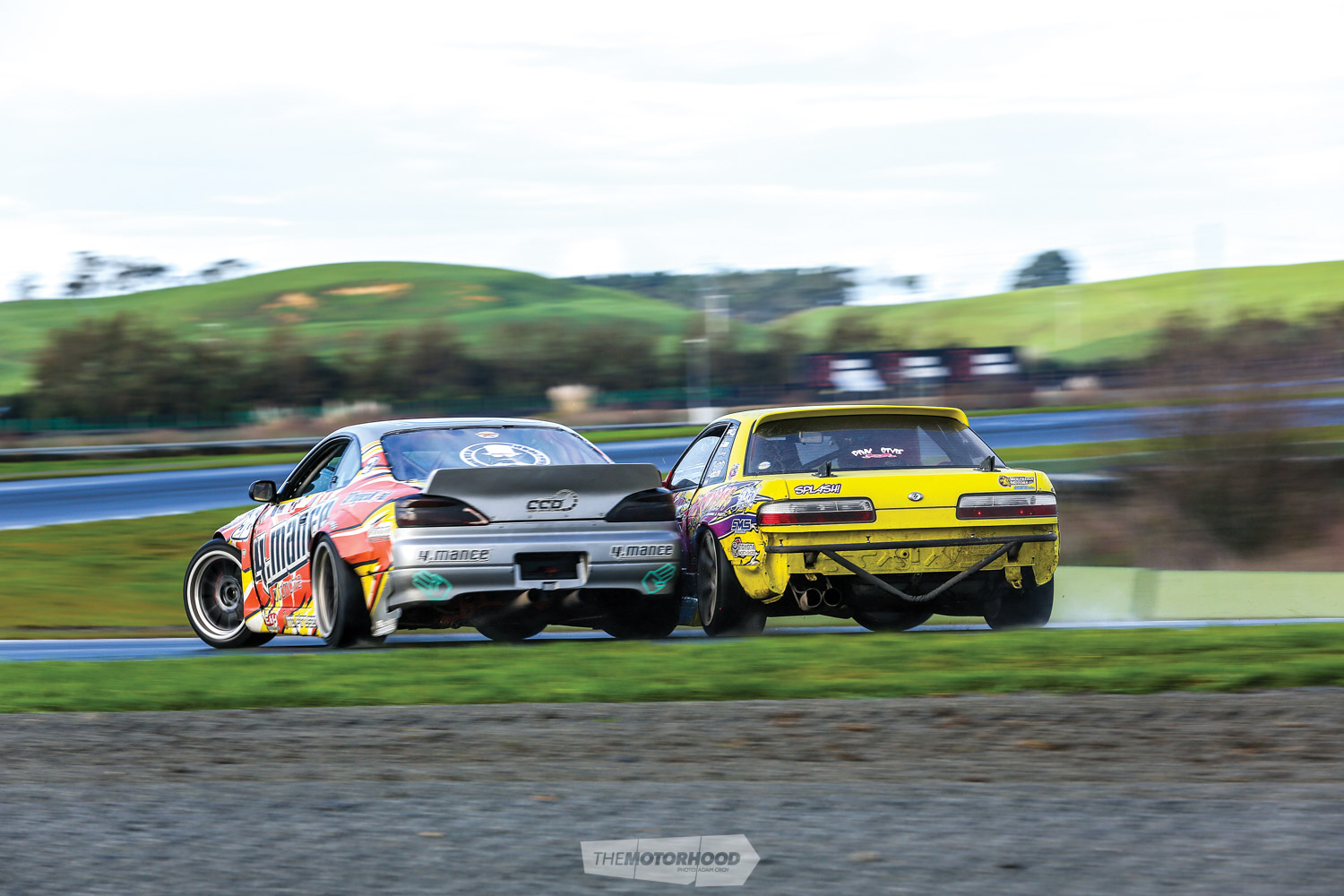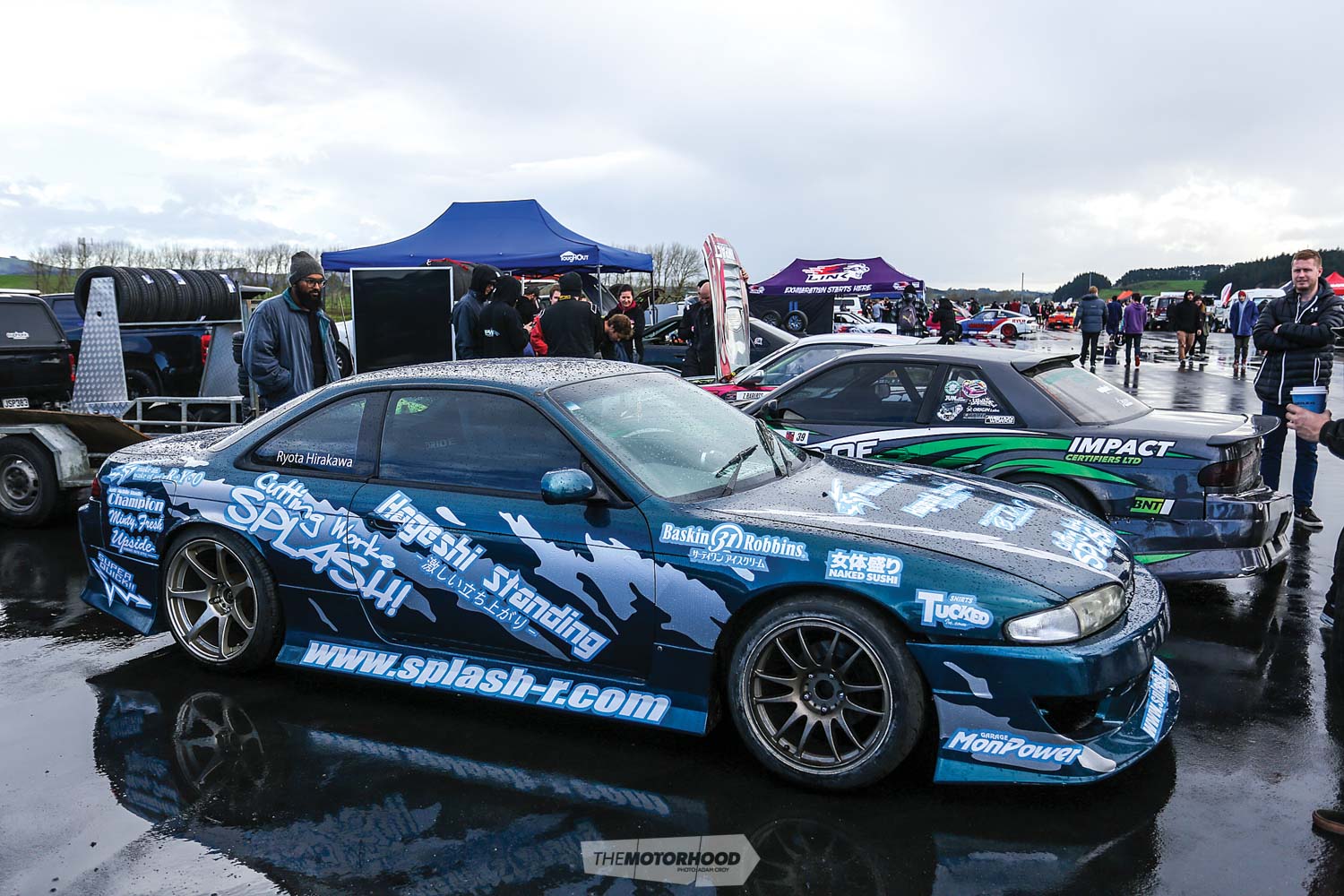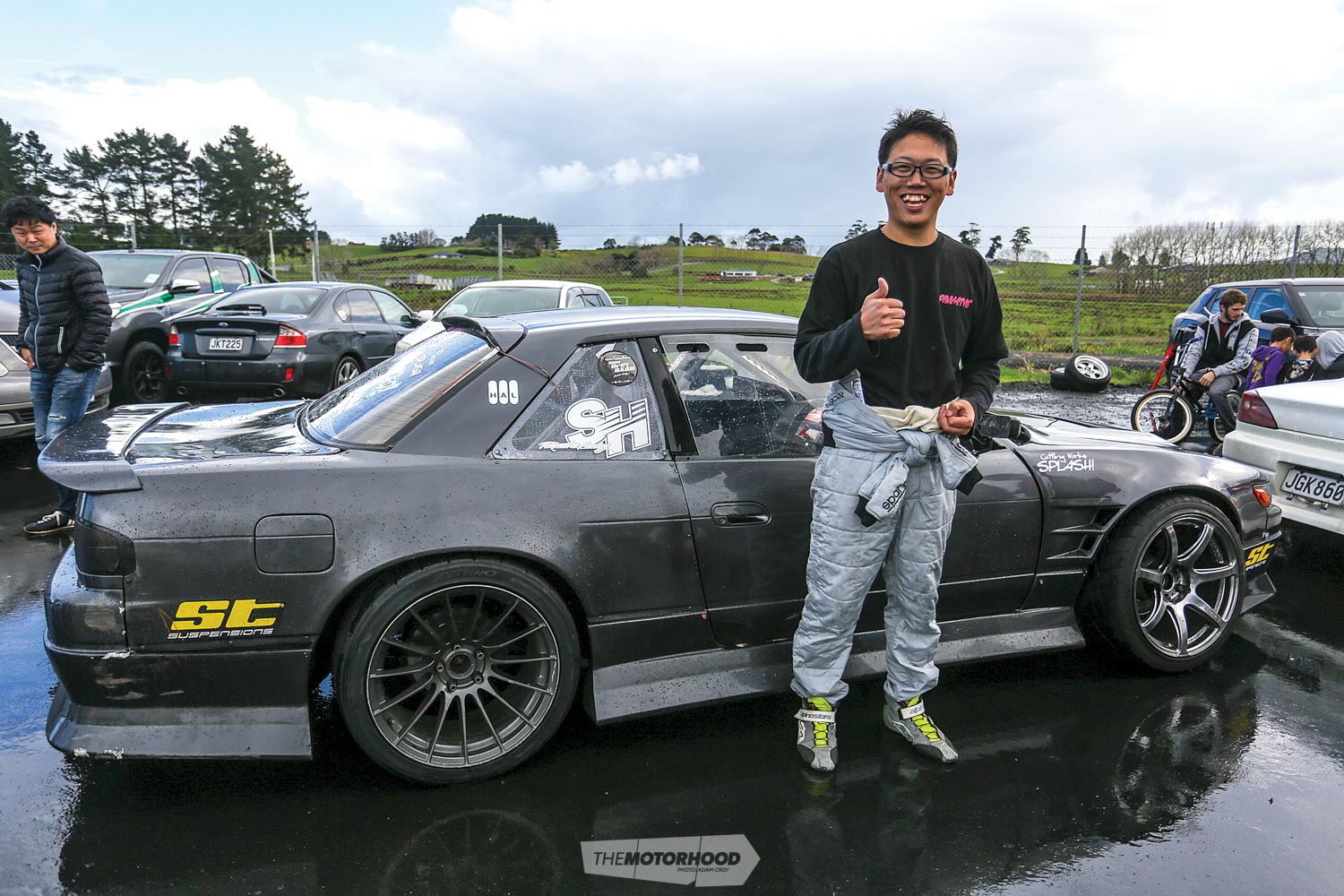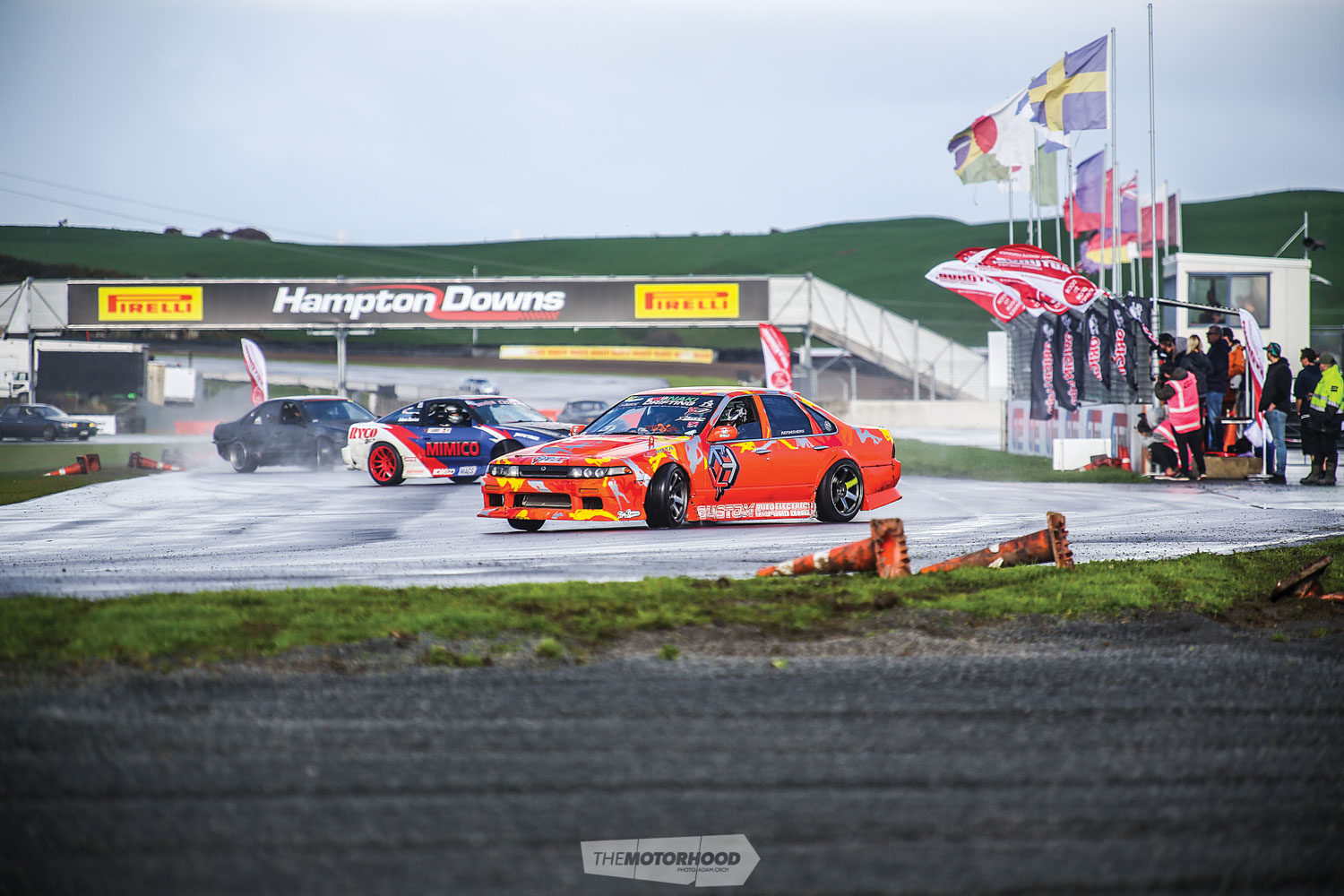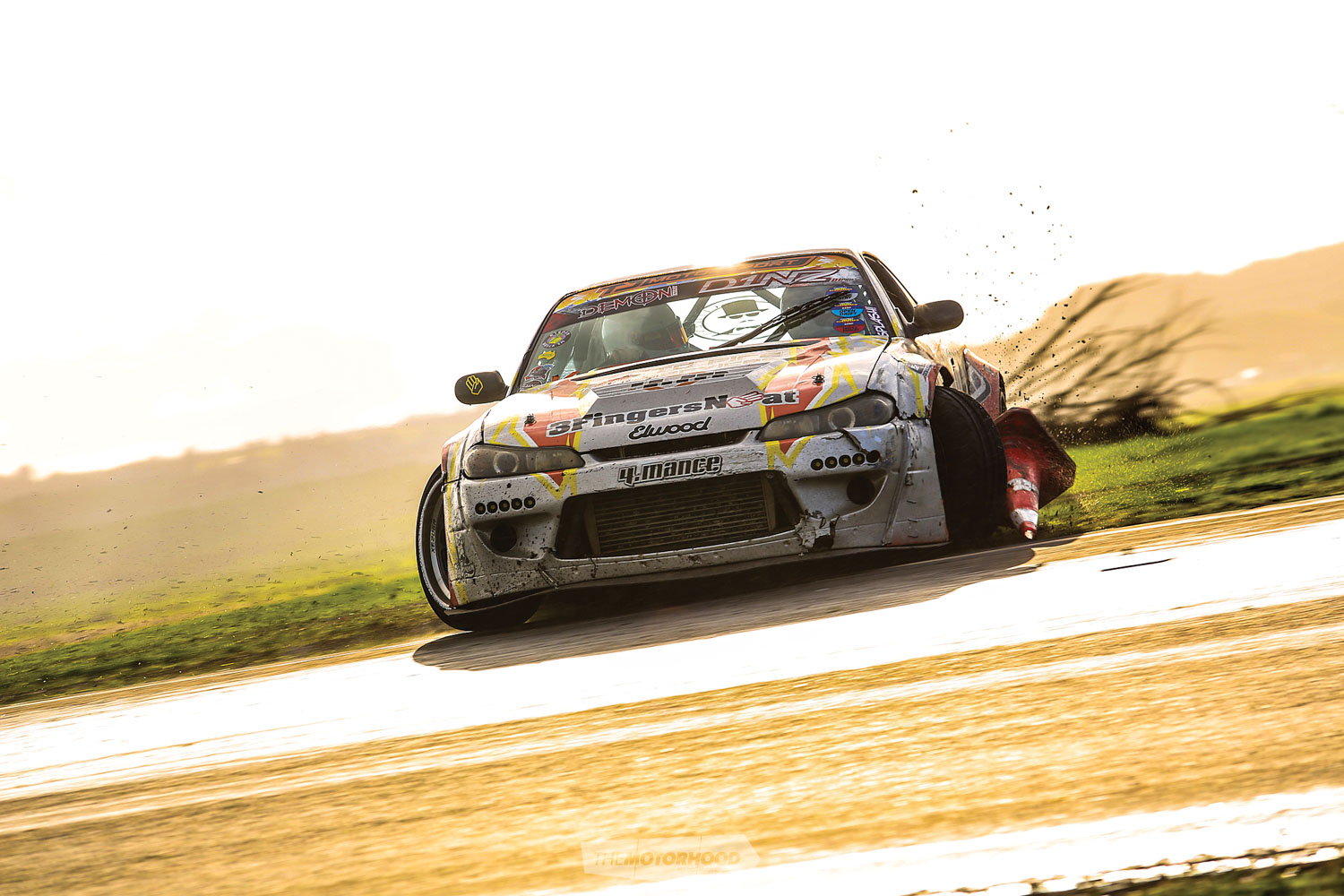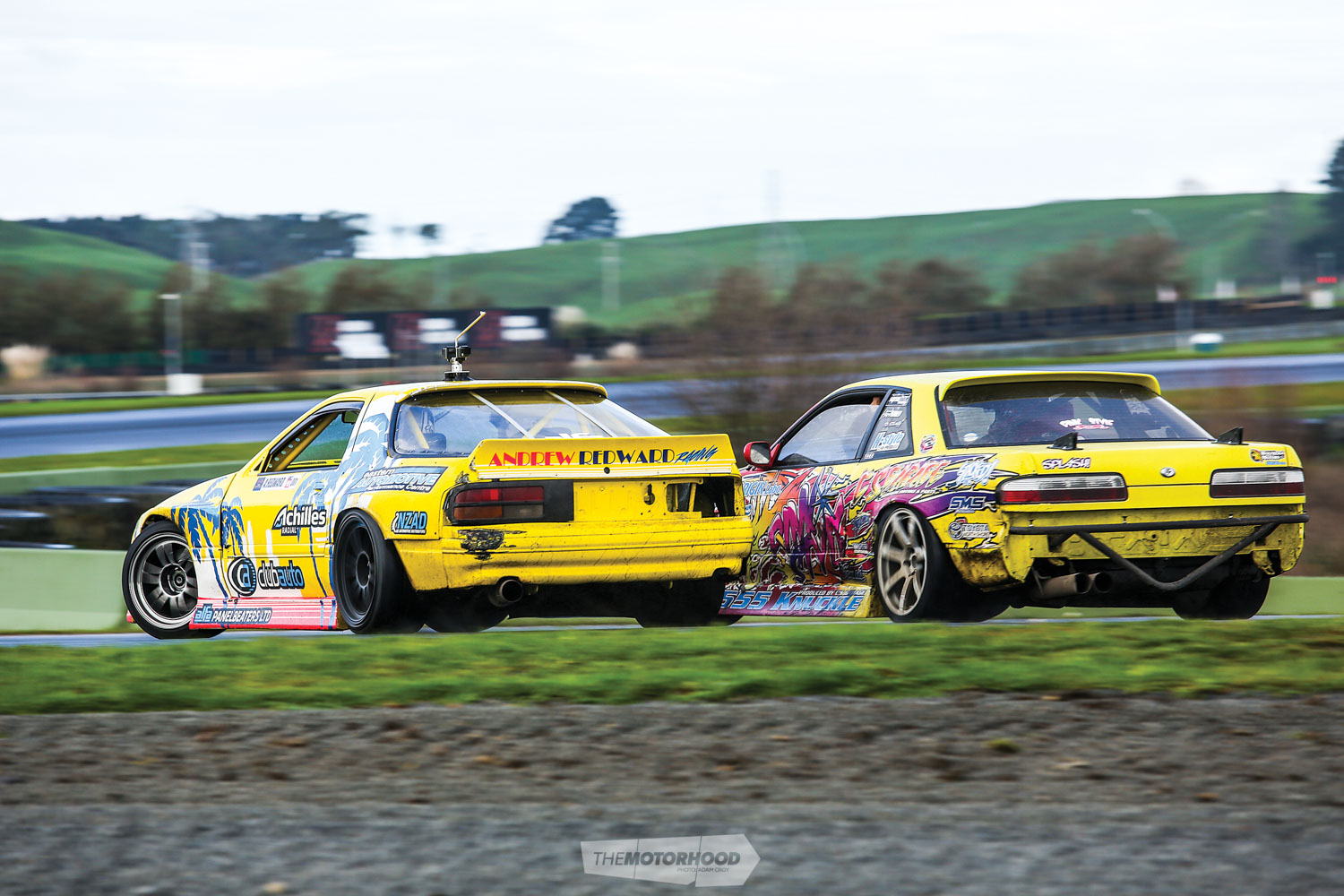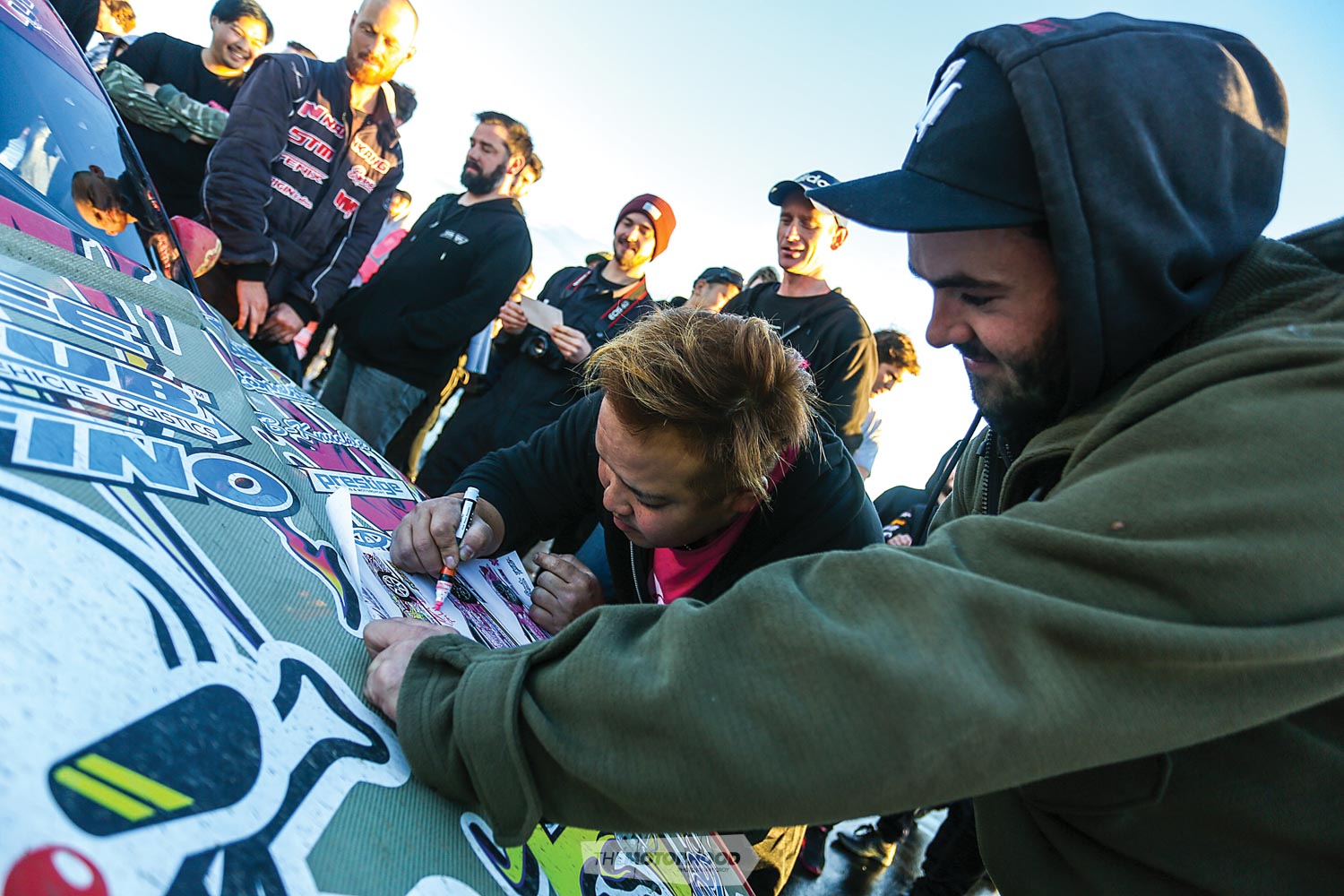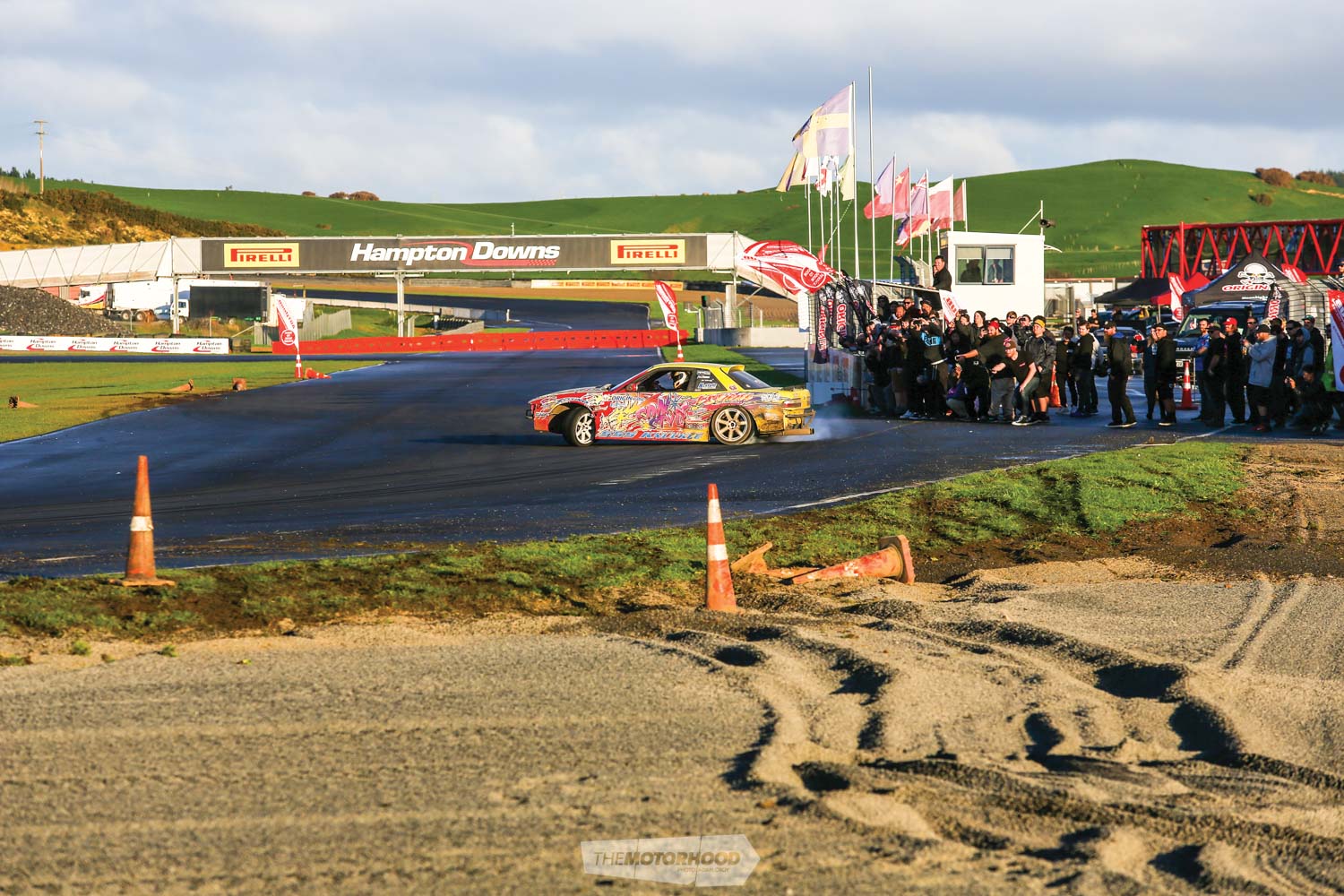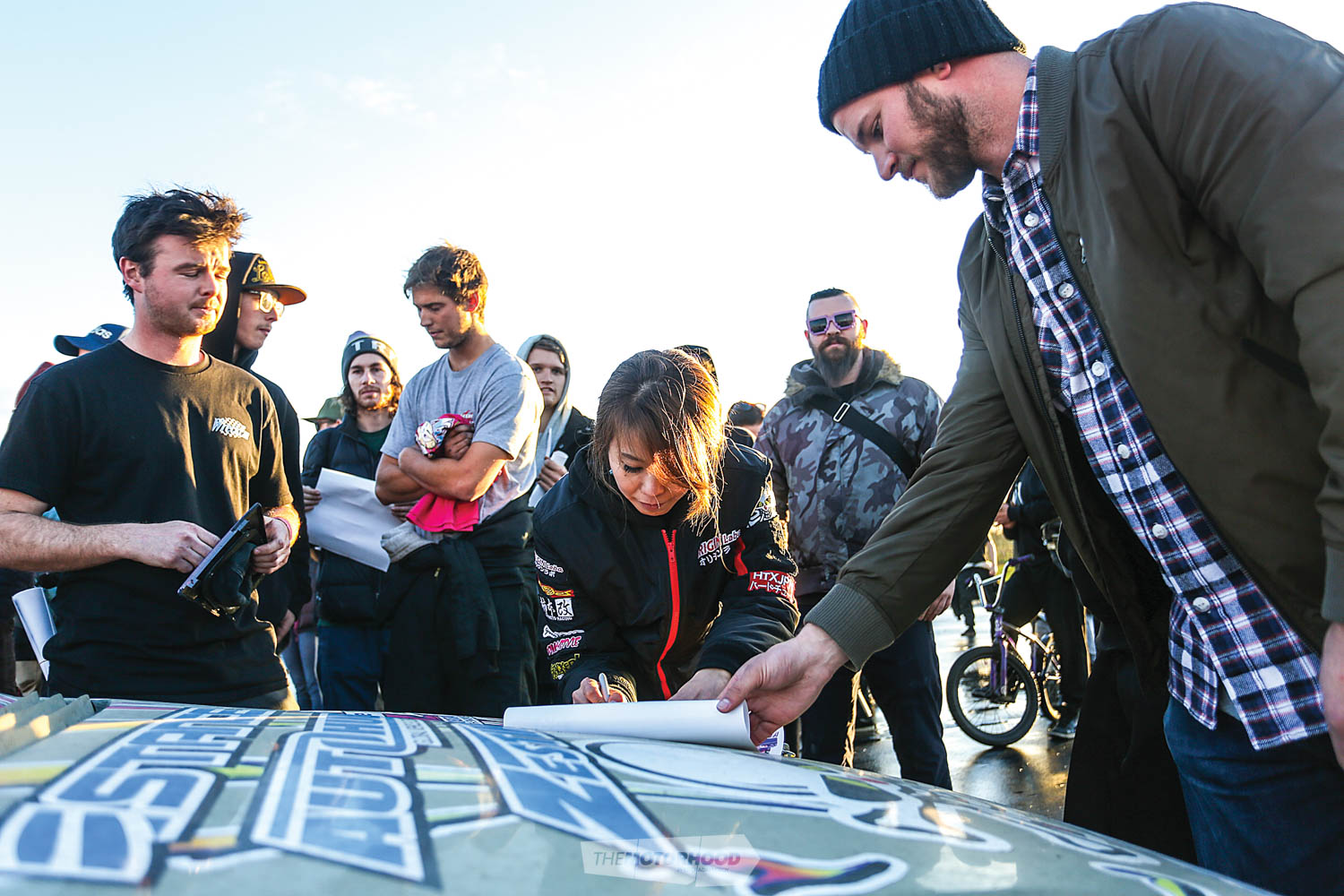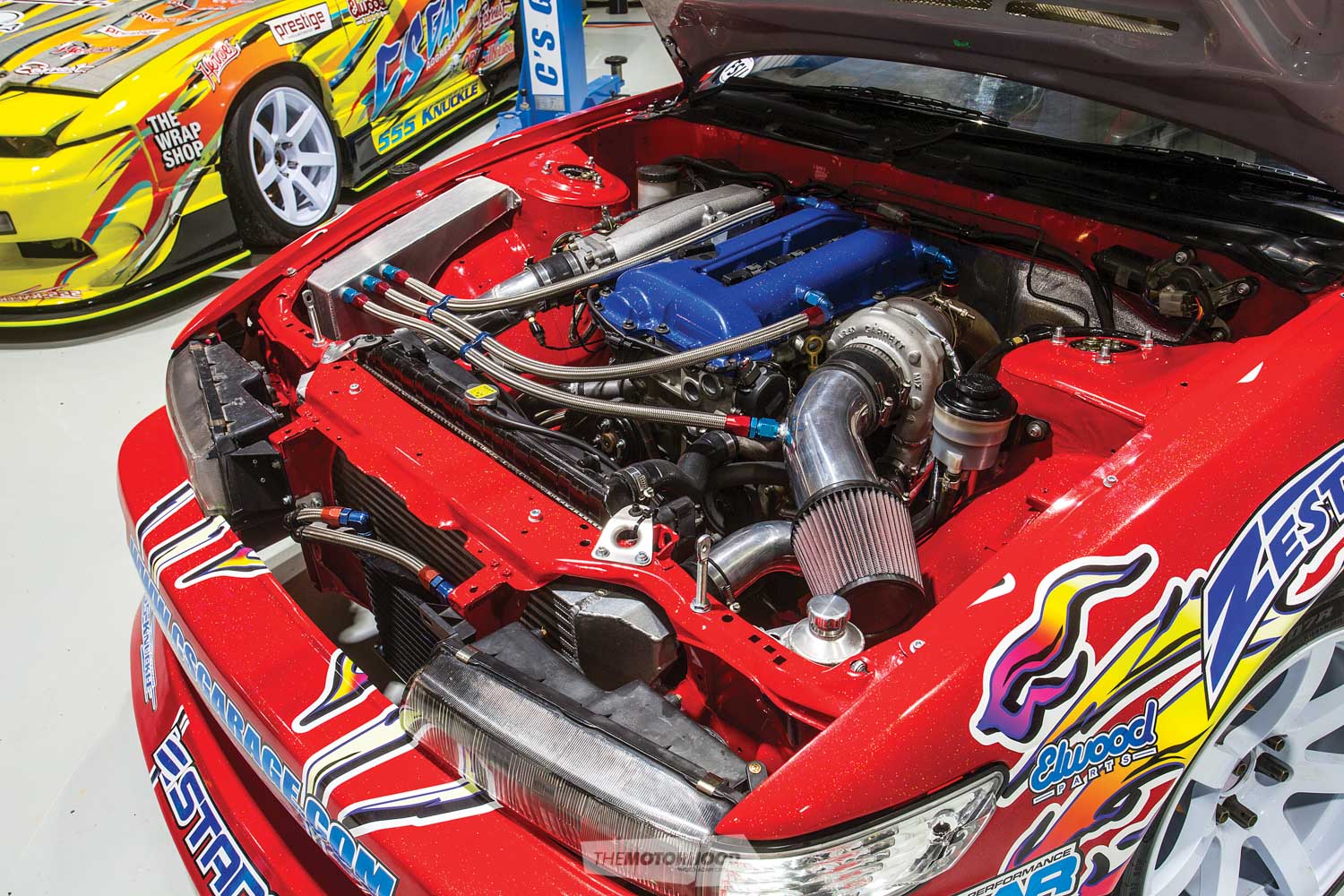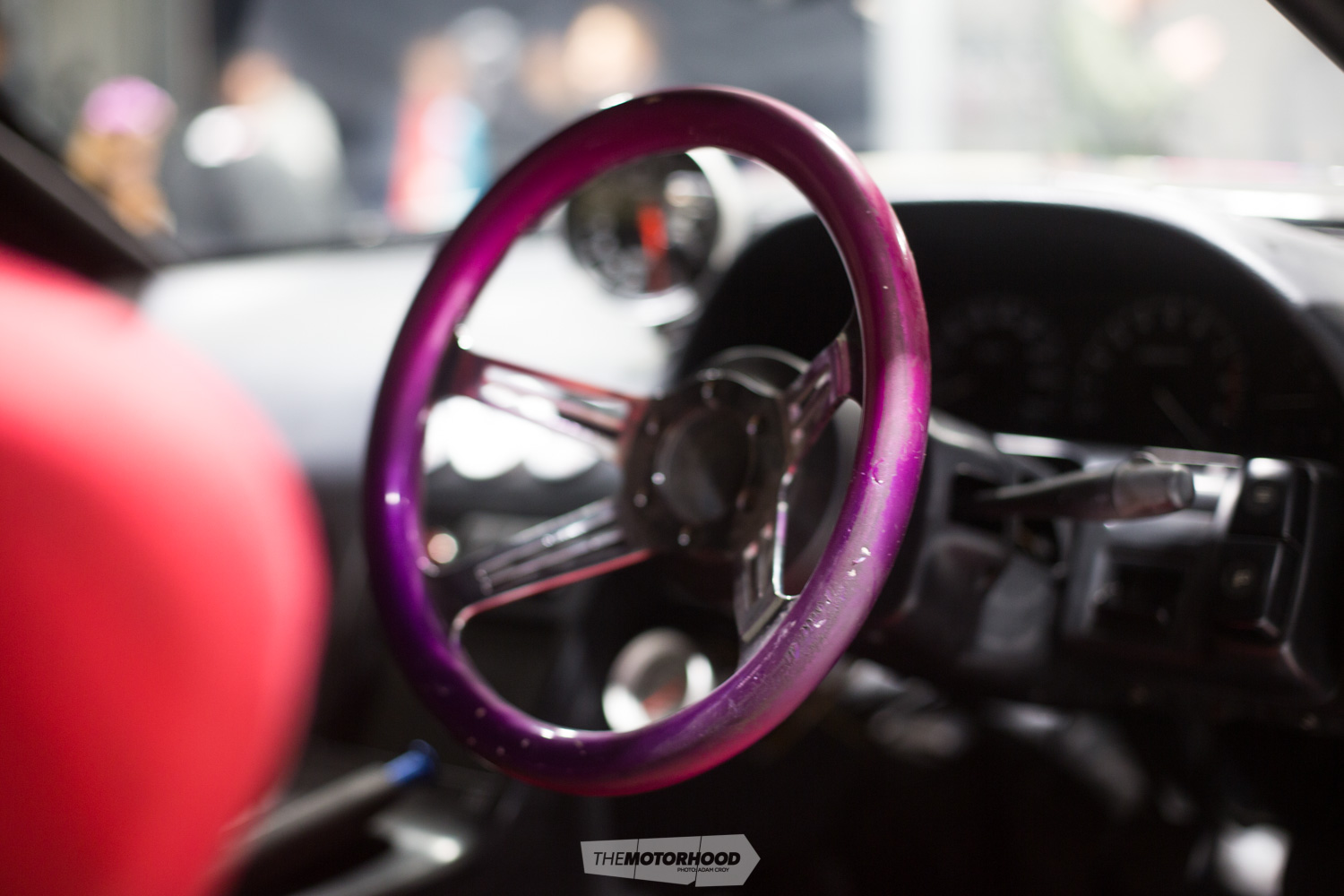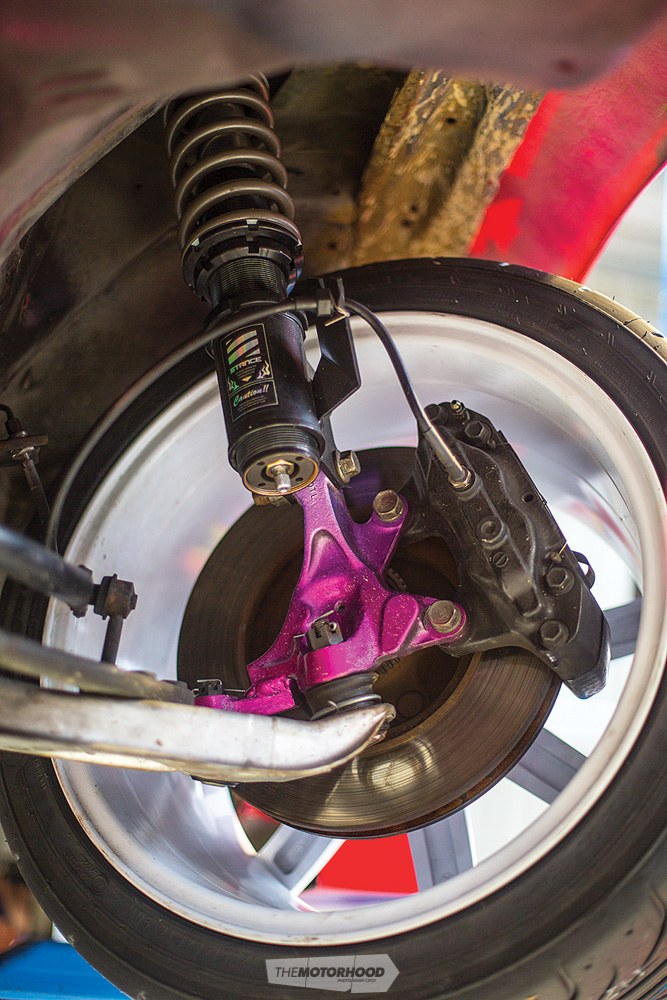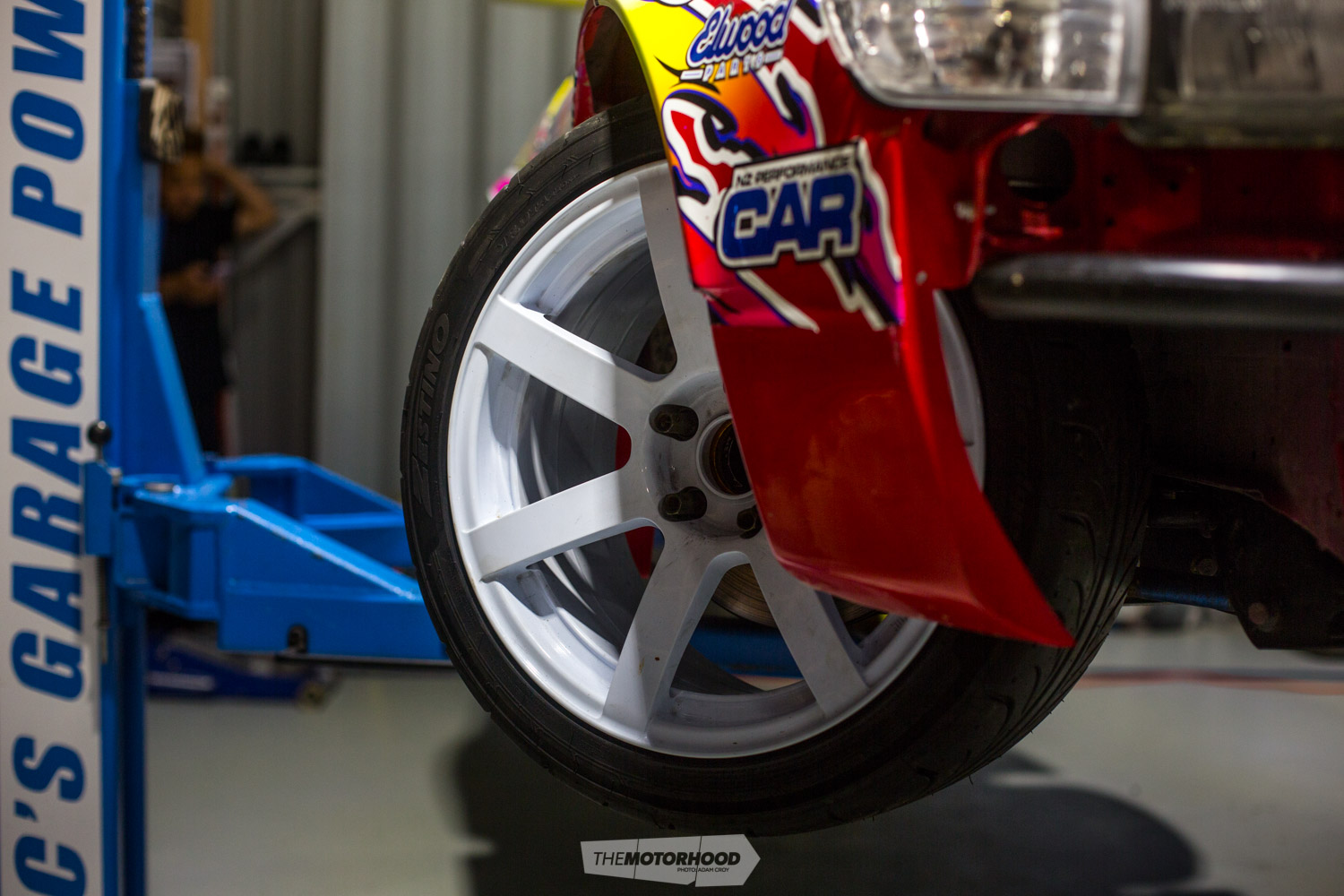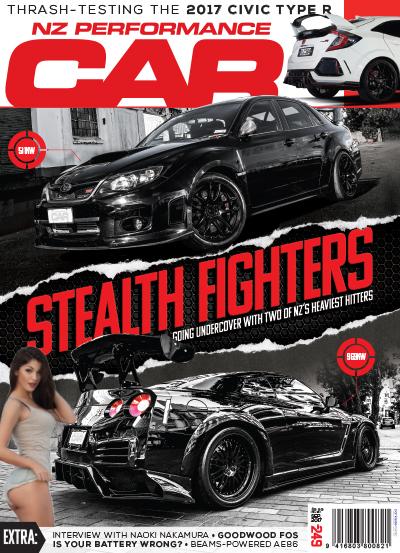After a trip to Meihan Sportsland (Japan) seven years ago, the C’s Garage boys knew that one day they would bring world-renowned drifter Naoki Nakamura to our shores. What eventuated was a true masterclass in Japanese-style drifting
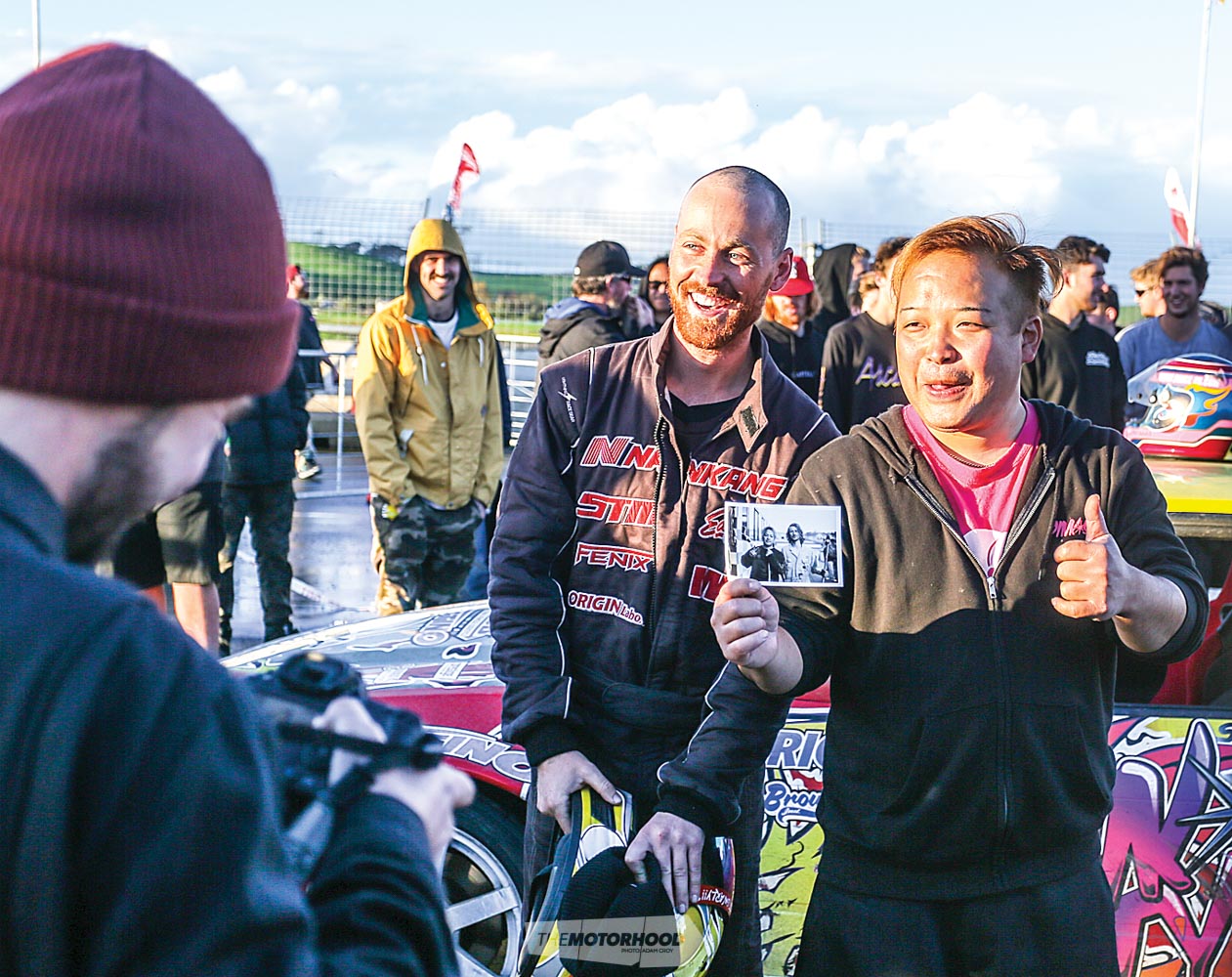
The event
Pause for a moment, and reminisce about your younger days watching potato-quality videos of wild Japanese cars hacking up the mountain passes and sending rows of sparks down the infamous Meihan Sportsland walls with their wings. Without a doubt, you would have seen one driver who would push that little bit harder, further, and faster. His name has become separated from those of the mere mortals of drifting, and anyone who has ever had even the faintest interest in driving sideways should recognize it — yep, we’re talking about Naoki Nakamura.
Hailing from Nara Prefecture, Japan, Nakamura-san is known as the fearless leader of Team Burst (now renounced) and, in more recent years, Pink Style, and the proprietor of drift car–building shop N-Style, while simultaneously revered for his incredibly aggressive, fast-paced driving style. It was there in Nara, home to Meihan Sportsland, that, in 2010, Kiwi boys Adam and Joel Hedges from C’s Garage witnessed the sheer force that is his driving style. “We saw something that the rest of New Zealand needed to see … what they are doing over there, compared to what we do back here, could well be categorized as two different sports,” Joel says. “Nakamura-san is, without a doubt, in our minds, the best driver in the world — by a long shot. We thought [that] if the team back home could witness this kind of driving, it would do wonders for the sport locally.”
They kept that goal in mind, but it wasn’t until seven years later that the stars aligned and D-Club Pink Style GP was born. A dedicated group of Kiwis took care of details locally, while Shane Bingham from Stacked Inc. arranged to get our Japanese guests — including the second half of Pink Style, Miki Takagi, the D1 Ladies League champion in 2014 and 2016 — down under.
The weekend was split into two events, kicking off with a very limited-numbers driving school offering an invaluable opportunity to share driver knowledge and skill, while Sunday saw a demonstration of raw talent as drivers from both countries took to the Hampton’s Club circuit. This was a true masterclass in Japanese-style drifting. And it also gave us the chance to sit down with Nakamura-san and Takagi-san for an exclusive interview to find out just how they got so damn good, what their thoughts are on New Zealand driving, and how we should be doing it.
We have a full event report and gallery here
The interviews
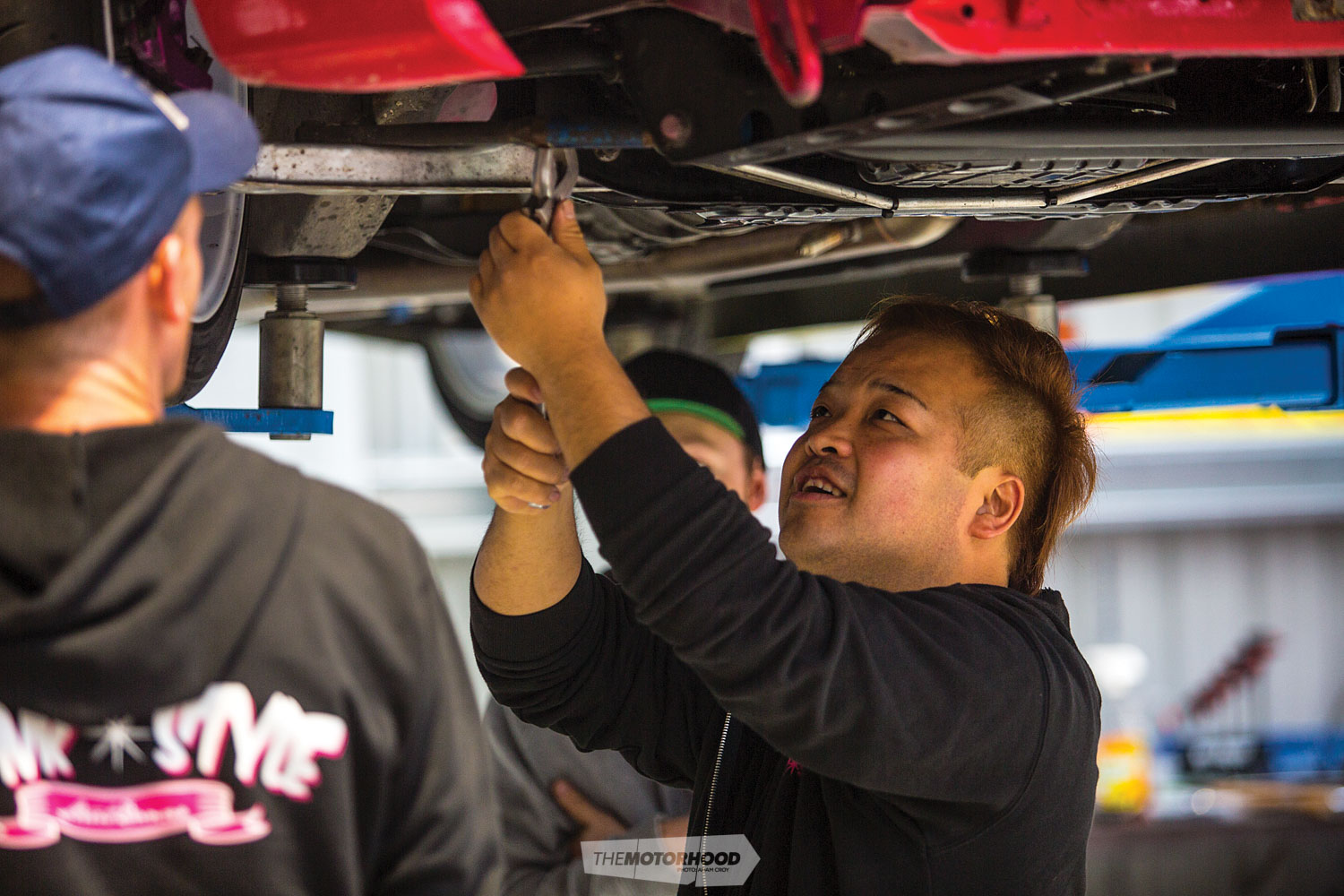
Naoki Nakamura
Age: 35
Location: Sakurai city, Nara Prefecture
Team: Pink Style
Car: Nissan Silvia S13
Wins: D1 Street Legal 2009, 2010, and 2014 champion; D1GP 2014 second place; Drift Muscle Japan 2011 and 2012 champion; King of Asia champion 2015; King of Nations (Japan) Nikko 2016 winner and 2017 runner-up; King of Nations (Japan) Ebisu winner; Drift Challenge Australia round-one winner; MSC Japan 2010 champion; Kansai Allstars 2012, 2014, and 2015 champion; West Japan Allstars 2016 champion
NZ Performance Car: Kon’nichiwa, Nakamura-san. Welcome to New Zealand. Tell us, at what age did you start tinkering with cars, and why was that?
Naoki Nakamura: Thank you. I was 17 when I started drifting … when I was a teenager in school, I went to see a touge. At the time, I was into bikes — little scooters and race bikes — and I went up into the hills and saw the guys out there and wanted to do what they were doing.
What was the first drift car you bought because of that experience, and how did you modify it?
The first was a Sileighty … it was a CA[18DET] with coilovers and a diff. I killed the CA around seven times. The first engine died in two weeks — this was before I understood that stuff broke, and [I] just drove the car.
Were you ever scared of getting caught drifting it out in the mountains?
The police tend to turn a blind eye to it [in Japan]. You must be responsible and not do anything wrong, or you get in a lot of trouble. You drive real slow up the mountain and make sure there are no neighbours to bother, and that’s how it becomes a touge spot. If you aren’t doing anything wrong, they [police] will leave you alone, and if the police come out to the mountains and tell you to go home, you should leave and not go back.
When did you go from touge runs to track work and competitions?
It was when I was 20 or 21, I had decided to enter comps as I felt I was getting better in my driving. In Japan, the scene is combined — if you go to the circuit for a track day, you will end up doing comps, too. They will have a comp after lunch or something like that, they call them ‘mini comps’ — most often they will give you a trophy for first, second, and third. You start doing those mini comps, and, if you do well, you can move onto the bigger comps such as D1SL. I tend to go to the track at least once a week.
In 2010, you were caught street drifting in Osaka. How did the police react to catching you, and what did that mean for competition driving?
You are a lot more responsible for your actions when you are a professional driver. While some cultures may be easy-going, Japan is more rigid with professionals, and to be caught up in an irresponsible thing, it becomes more of a cultural issue than a law issue. I was told to go home but didn’t, as I wanted to practise. I didn’t so much get in trouble with the law, although culturally it was a big thing for me, and it changes how people think of you.
I also lost my licence for a few years. Japan runs the FIA licensing system through JAF [Japan Automobile Federation], which requires you to have a current driver’s licence to have an FIA permit — without the FIA permit, I couldn’t race, and that’s why I’m currently still not competing in D1.
Your competition cars have always been Silvias — are they your preferred chassis?
I did like Laurels back in the day, but Silvias are where it’s at. I love how they handle and how they look. We tried the 1JZ heart, but SR engines sound really good to me.
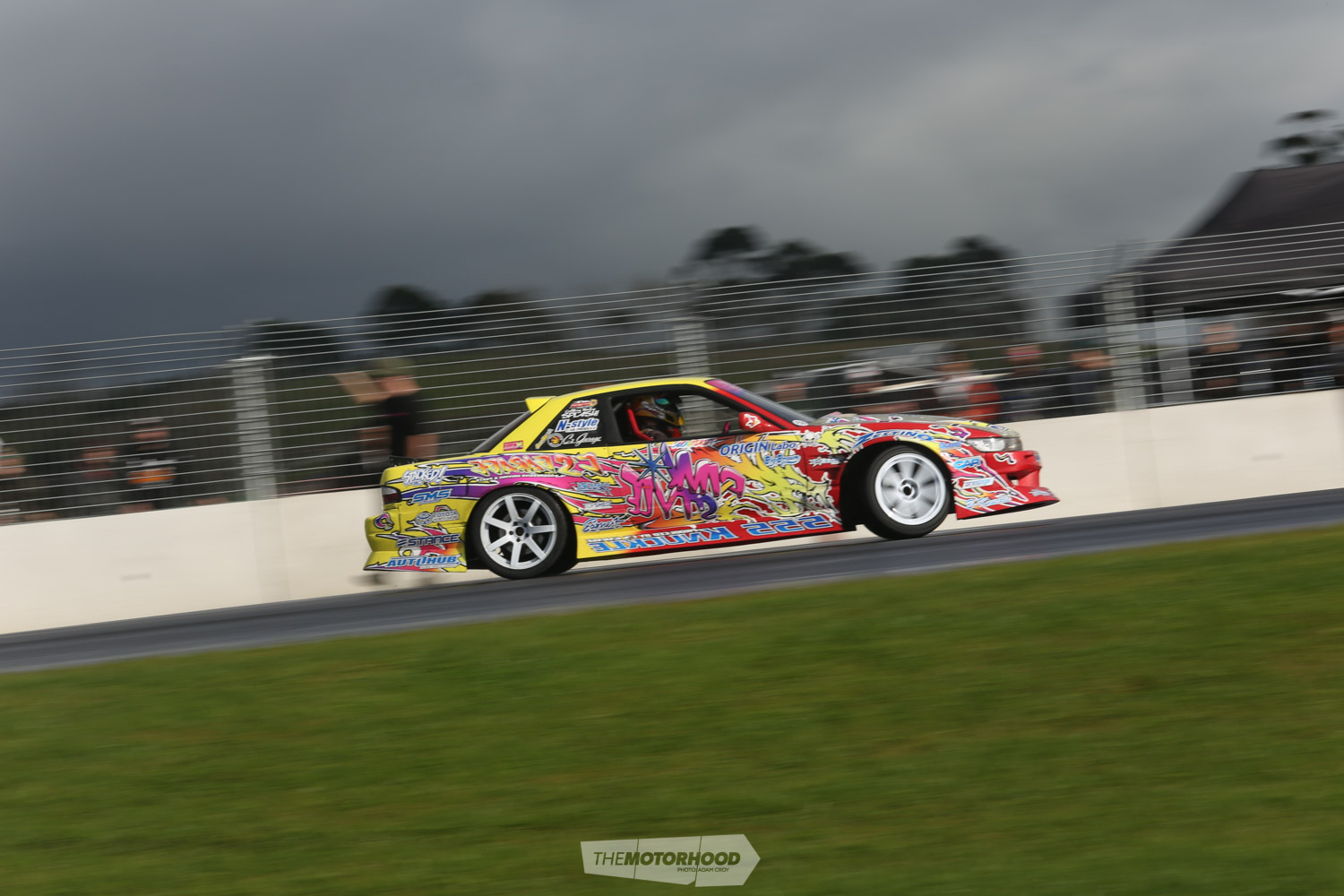
And what inspires the liveries and styling of your cars?
I wanted to show off to the girls when I was younger. My bikes and then cars were pink, and my buddy [Aki] Fujio’s team — Otokichi Family — from the prefecture over, was purple. We were always driving together in the mountains, and we joined together instead of becoming rivals. That’s how we became pink and purple in Team Burst. Back in those days, there wasn’t the technology to print and cut stickers for the cars. Everything was hand-designed, guessing and winging it, and, if you liked a dragon, then you went to the library, photocopied an image, and traced it out on a sticker, cut it, and slapped it on.
Do you enjoy working on them?
I’d rather be driving, so I don’t enjoy working on the cars. I do it every day at work, too [at his shop, N-Style], which means I don’t want to work on my own at the end of day, but you have to do it to drive. I do enjoy painting the cars, though.
You’ve travelled around the world to drift. What are your thoughts on the drifting you have seen internationally?
Western culture is very concerned about how good the parts are. People want the good parts and to be all clean. The products are just a tool to get the job done. For us, driving skill and the contest [are] … more important. We focus on getting the car to do what it needs to do — if something is about to fall off, I don’t care, but if the setting isn’t right, that may stop me winning the competition. Our driving style is also a bit different to that of overseas. While many Western cultures are about taking off fast, we are about slowing down fast. I like going overseas, as there are lots of things to compare, and I like that experience.
People know you for aggressive, fast-paced driving. How would you describe your style of driving?
I like my driving style to stand out more than others … if everyone is managing this much angle, I want to do that much more: if everyone is making this much smoke, I want to make that much more smoke — that little bit extra. That’s the attitude I put into tuning my cars and driving … I like to go fast, too.
How do we do on that scale?
New Zealand drivers try very hard and have confidence in driving; however, the cars need some work to set them up correctly for good driving. Lift the cars so [that] the wheels aren’t hitting everywhere inside the fenders and alignments so [that] your wheels are pointing in the same direction. I also noted that speed is less important here than in Japanese style, and there isn’t as much drive time as back home. Perhaps New Zealand drivers can drive faster and more accurately.
And what did you think of the shop car that C’s Garage built for you and Miki to drive?
A lot of effort has gone into the car that the C’s Garage boys built. I was very happy to be driving such a well-built car, and I appreciate the extra effort that they have gone to when building it. The car was on low boost for the event and had a fairly strong safety margin, so I really look forward to driving it again in the dry next time, so we can dial it up!
What advice would you give to those drivers coming up in the drifting world?
Naoki: Driving is number one. Drive the wheels off the car and push it harder. If your car’s slow, push hard anyway; it doesn’t suck to drive a shit car.
Shane Bingham: Some of the practice cars [that] he drives back home are shit. Broken things, flat tyres, whatever, but it’s a good thing, as it’s a challenge — it limits him and makes him push harder to achieve what he’s trying to do in it. A lot of the cars he drives, he won’t care, and if it’s not critical, he won’t touch it. If you can drive around those problems, it teaches you a lot of skills for when you jump back into the pro car.
Naoki: If you drive a fast car and a shit car, drive [them] … at the same speed, and push hard. This is how you will learn, from experience.
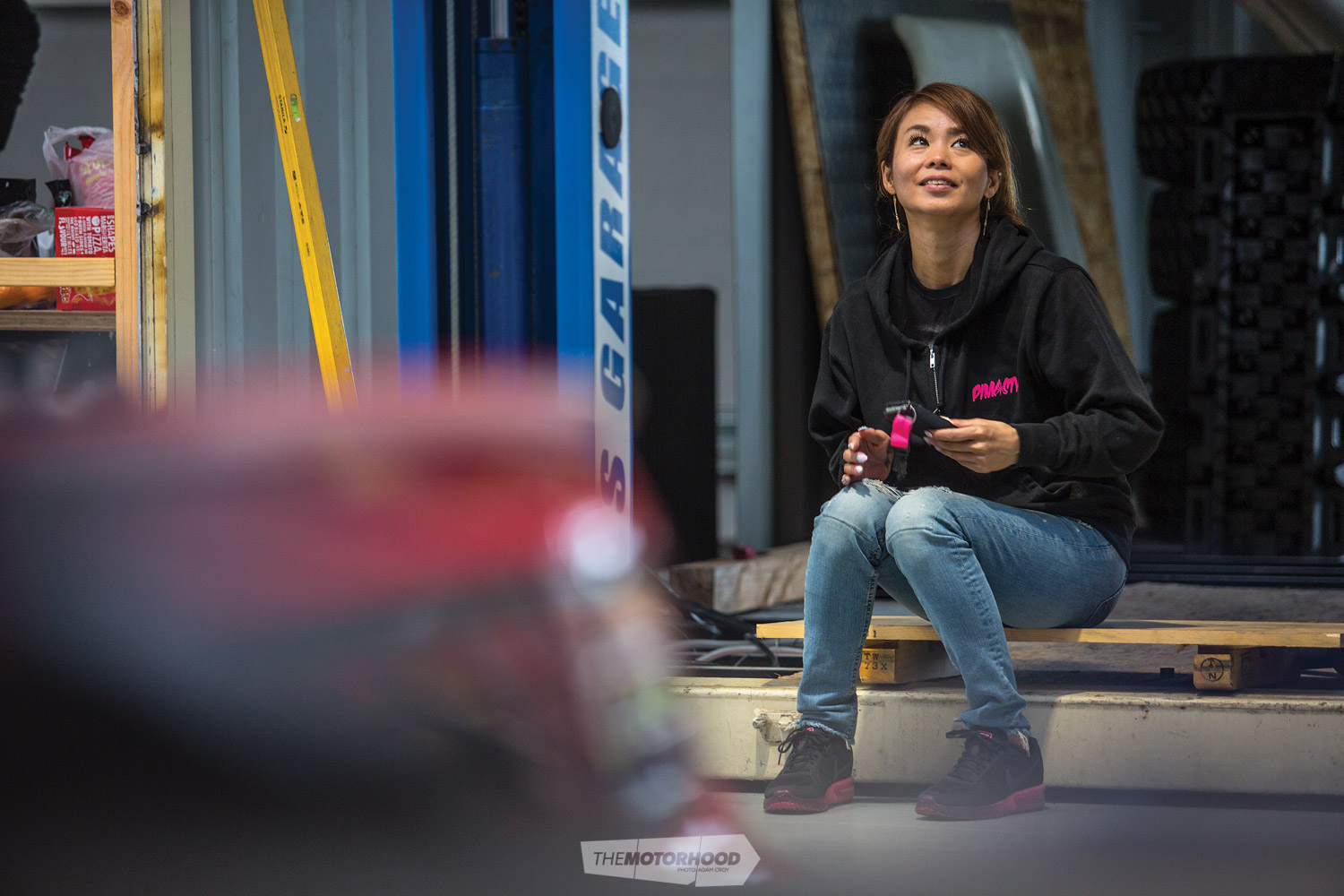
Miki Takagi
Team: Pink Style
Car: Nissan Silvia S13
Wins: D1 Ladies League 2014 and 2016 champion, Drift Muscle 2017 Meihan winner
NZ Performance Car: Kon’nichiwa, Takagi-san. Welcome to New Zealand. As a female drifter, how did you find your passion in cars?
Miki Takagi: When I was younger, I quite liked sports cars and race cars, so I bought an EF Civic. I put wheels, coilovers, muffler, all that — shakotan style. As for drifting, when I was 22, one of my friends took me out to watch. They said “Hey, I’m going drifting, come take a look.”
What was it about the drifting you saw that you really enjoyed?
Because of the flare, the show-offy side of it. I liked showing other drivers your driving skill and showing off what I could do behind the wheel.
What was the first drift car you bought because of that experience, and how did you modify it?
My first drift car was a Nissan 180SX … I did all the usual things, like installing coilovers, muffler, LSD and wheels, then took it drifting.
Did that 180SX ever get you into any trouble out on the touge?
No, no, I never really got into the street side of it. I was always too nervous, a little scared to get into trouble. I’ve been out to the port a few times, but touge never really came until I met Naoki …
Do you take more of an interest in the looks of your cars?
Miki: Yes, I like to keep my cars clean …
Naoki: You don’t like to clean up though …
Miki: Sometimes I pretend I can’t do things so Naoki will do them instead [laughs].
Speaking of Naoki, how did you two come to meet?
Naoki: We met when we were much younger … I saw her and said, ‘oh cool, look a drift girl — she sucks’ [laughs].
Miki: We came together [as a team] much later than that. Around 2010, when Naoki got into trouble, we formed Pink Style.
Naoki: One of the rival shops nearby was looking after Miki, but they were giving her shit all the time and being mean, and I felt that was unfair, so I took her under my shop [N-Style]. I began teaching her, and now she has become very good, which is why she wins everything.
Team drifting is very big in Japan compared with overseas, such as here in New Zealand. What’s the draw to form these teams?
The Japanese culture is like this — in the workplace, or in your hobby, you tend to follow a leader. That is reflected in drifting, too. As Naoki said earlier, he took me under his shop and taught me how to drift well. Now we are Pink Style, our own team.
And how do you find it being a female driver in what still is a male-dominated sport?
A lot of the guys have a lot of pride, and they can be really mean to the girls because of that. The guys will try to limit how many there are, for the risk of losing to the girls — ‘no, you’re not in my group’. But we keep driving, and winning, to show that girls can do it, too.
The car
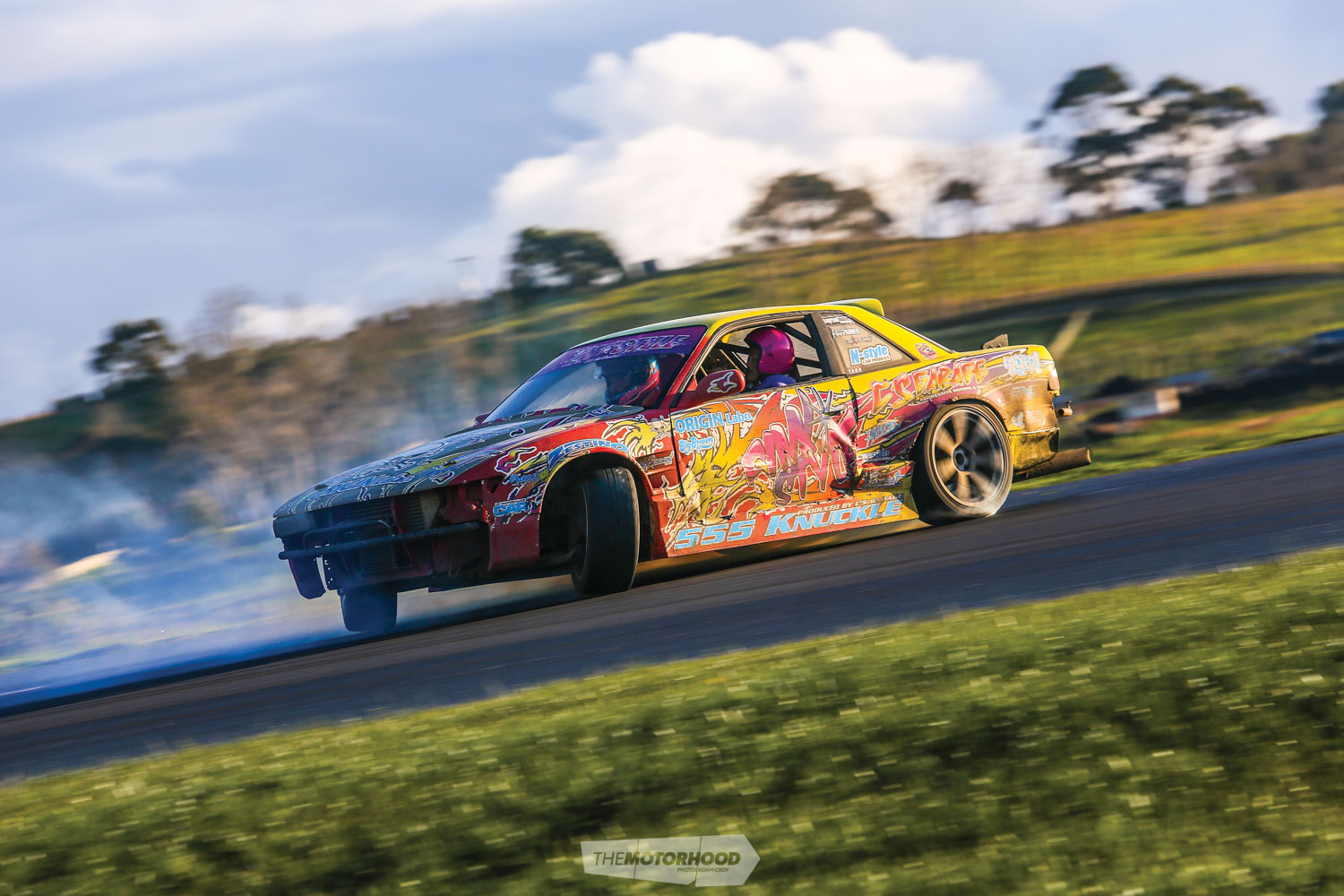
When you’re planning to have international guests such as Nakamura-san and Takagi-san carve up your local tracks, you don’t just throw them the keys to the old dunger out back and expect them to perform miracles. Nope, that just won’t do. So the C’s Garage boys went all out on this one, with the help of a few key friends, and transformed their S13 shop car that had been parked up out back into a Japanese-spec battler. It was an undertaking that saw C’s Garage’s Adam Hedges take two months off work to see it through, with Graeme Smyth from SMS Fabrication also spending a fair chunk of time on it alongside him.
So, having sat in the paddock for a few years, the 13 was pulled out and thrown into the shed — it was a fitting choice of chassis considering both Japanese drivers use the same back home. Minus a working motor, the body was quickly stripped back to the bare basics in preparation for phase one of the wild aesthetics. The choice of kit was a simple one: the same Origin Labo Aggressive Line example that can be found on Naoki’s car back home. Reuben from D-Club offered his workshop for the paintwork to commence, which saw it all covered in a fresh lick of the C’s Garage iconic yellow and red combo (albeit reversed), while C’s Garage’s Joel Hedges sat down with Ash from Hero Prints to smash out a bunch of very late nights as they pulled together the livery for the car — later carefully applied by the team at Big Brown Industries.
On the mechanical side of things, a spare S15 SR20DET was dropped into the engine bay and paired with a stronger Z32 box because, as Adam joked, “The drivetrain [needed to be] as strong as possible, because Naoki is rather hard on the gear.” And, to ensure it all gelled together, Chris Wall from Prestige Tuning and Motorsport was tasked with tuning duties.
Things started getting out of control from there, with parts arriving in piles from Nakamura-san himself, including a pair of his B Knuckle knuckles, modified in-house at N-Style — these being S14 cut-and-welded examples. The major difference between Naoki’s own steering set-up and how we tend to do it here is that he uses stock-length lower arms with lots of wheel spacers to gain the desired wheel clearance at full lock, giving the car a ton of scrub radius.
Along with the knuckles, a set of Stance D1 coilovers arrived from the US with the spring rates and shock valving specced to suit Nakamura’s driving style. The front alignment was altered by the man himself to run a lot less caster than your typical drift alignment — as he doesn’t rely on the self-steering effect that a normal caster setting gives you to make the car snappy — which tends to suit the way he drives: aggressively, that is.
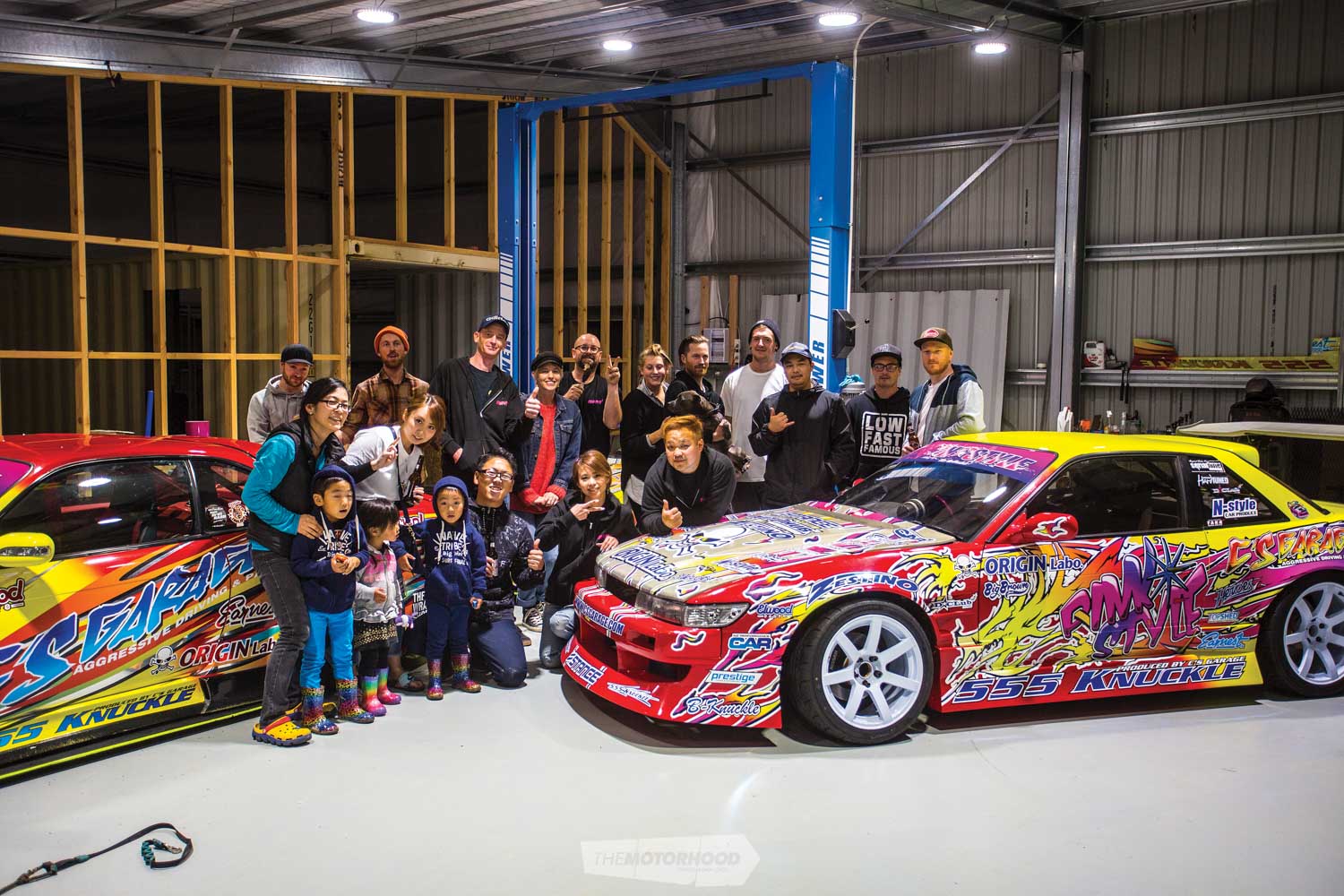
1991 Nissan Silvia S13
Heart
Engine: Nissan SR20DET (S15), 2000cc, four-cylinder
block: Factory
Head: A’PEXi metal head gasket; Tomei Poncams
intake: K&N filter, four-inch alloy intake
Exhaust: C’s Garage three-inch stainless exhaust, 3.5-inch twin tips
Turbo: Garrett GT3071R, C’s Garage exhaust manifold
Wastegate: Turbosmart 45mm
Fuel: Injector Dynamics 1050cc fuel injectors, DW300 in-tank fuel pump
ECU: Link G4+ Monsoon; wired by C’s Garage
Cooling: GReddy oil cooler, Koyorad two-core copper radiator
Driveline
Gearbox: Z32 five-speed
Clutch: Exedy five-puck single-plate clutch
Diff: Cusco two-way limited-slip diff (LSD) (4.6:1 ratio), C’s Garage custom 6×1 output shafts, Z33 axles
Support
Struts: Stance D1-Spec coilovers
Brakes: (F) R32 GT-R front calipers, (R) C’s Garage oversize rear rotors with stock cable handbrake
Extra: Cusco tension rods and toe arms; Parts Shop Max camber arms; JIC Magic traction arms; C’s Garage reinforced S14 front lower arms; B Knuckle knuckles; C’s Garage steering-rack relocation, reinforced rear subframe, and reinforced S13 rear knuckles
Shoes
Wheels: (F) 17×9-inch (+30) Origin Labo DNA02, (R) 18×9.5-inch (+15) Origin Labo DNA02
Tyres: (F) 235/40R17 Zestino Gredge 07RS; (R) 265/35R18 Zestino Gredge 07RS
Exterior
Exterior: Origin Labo Aggressive Line aero, Origin Labo 55mm front guards, Origin Labo 55mm rear guards, Origin Labo Type II silver carbon bonnet, Origin Labo silver carbon GT wing, C’s Garage front and rear bash bars
Interior
Seats: Bride seats; Sabelt harnesses
Steering wheel: N-Style steering wheel
Instrumentation: Auto Meter tacho; GReddy oil-temp, oil-pressure, and water-temp gauges
Extra: Six-point roll cage
Performance
Power: 280kW
Boost: 15psi
Fuel: E85
Tuner: Chris Wall at Prestige Tuning and Motorsport
Thanks: Naoki Nakamura, Miki Takagi, and Shane Bingham from Stacked Inc.; the D-Club team; Adam and Joel Hedges from C’s Garage; Graeme Smyth from SMS Fabrication; Origin Labo New Zealand; Stance Suspension USA; Nan from Zestino Tyres; Autohub; Stacked Inc.; Prestige Tuning and Motorsport; North Shore Toyota; Topshed; NZ Performance Car; Elwood Parts; Hero Prints; Earnest; Big Brown Industries; our friends, partners, family, drift friends, friends of friends, event volunteers, and everyone else who made it all happen — we can’t thank you enough
This article originally appeared in NZ Performance Car issue No. 249 — we can ship a print copy direct to your doorstep anywhere in the world, click the cover below to purchase






